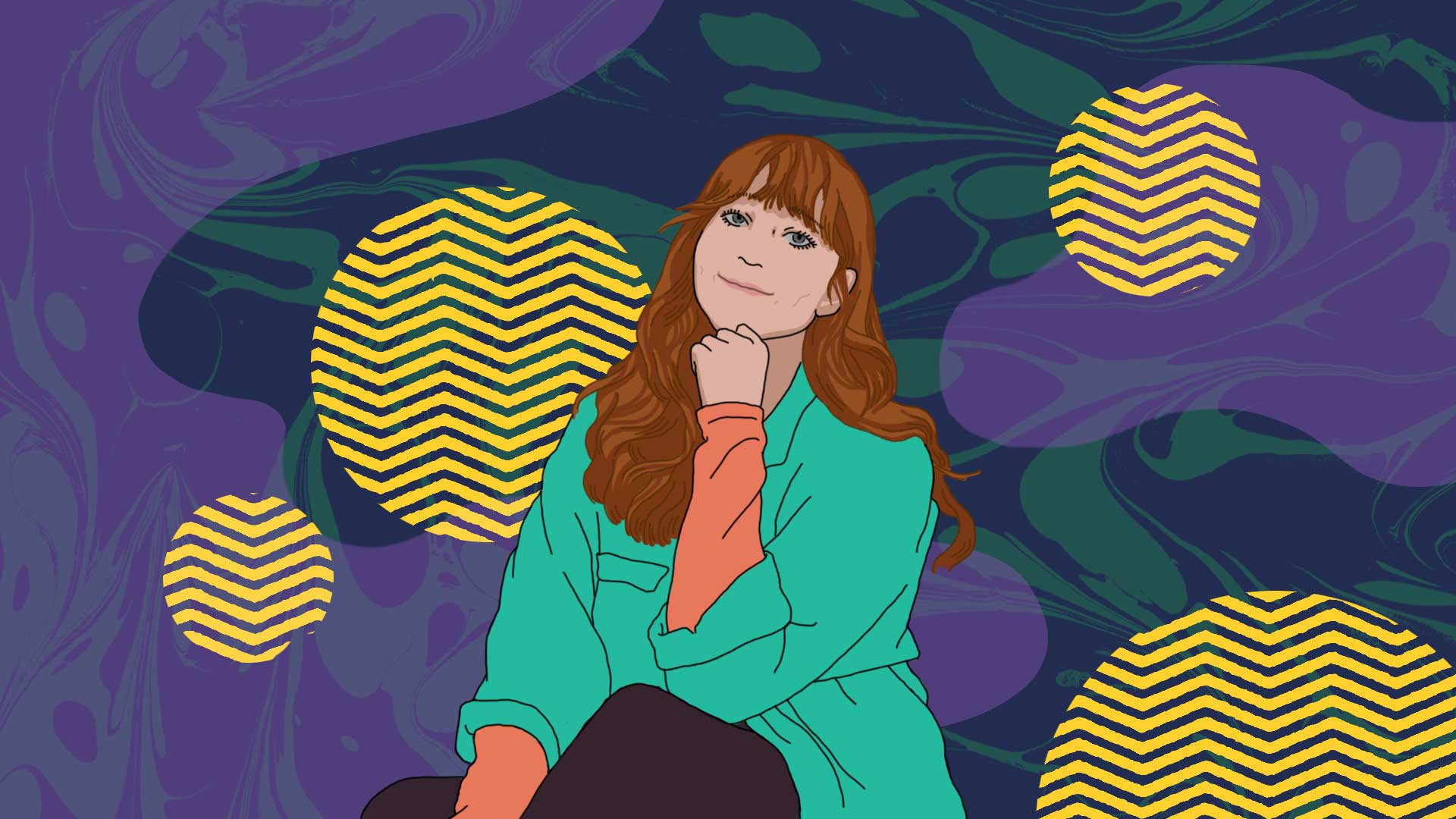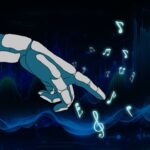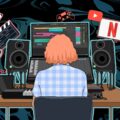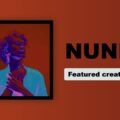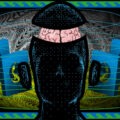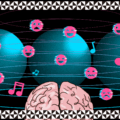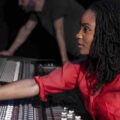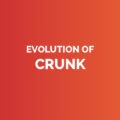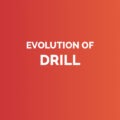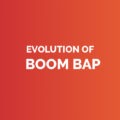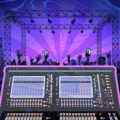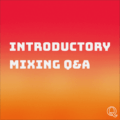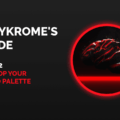Vancouver-based multi-disciplinary musician and visual artist Ciele Beau has always heard – and seen – music a little differently. Her striking audiovisual art incorporates her synesthesia, a neurological condition that mixes up sensory information in the brain, causing her to see colour and shapes when listening to music. This inspires her “Sound to Colour” practice, where she paints songs by translating sheet music to geometric colour blocks on the canvas.
Between writing pop tracks with millions of streams, creating immersive audiovisual gallery shows, and landing high profile video game sync deals, Ciele sat down with RAC to share her unique process and practice.
RAC: Please take us back to where it all began! How did you start making music and what first inspired you to write songs?
Ciele: I grew up in the Northwest Territories in a fairly isolated community and listening to music was a way of staying entertained. Growing up, my parents always had lots of different styles of music playing in the house and we were always singing together. Some of my earliest influences were Enya, the Rankin Family, and Angélique Kidjo – music where harmonies were really prevalent in the compositions. By the time I was 8 years old, I decided that I wanted to be a musician and started taking piano lessons and writing songs (not that they were any good). In high school, I took voice lessons and joined a hip-hop band where there were three MCs and I was the only vocalist. I wrote the choruses and we’d joke that I was like the Fergie of the group! The guys were incredible lyricists, and I learned a lot about writing and performing within a group context. At 19, I started taking my solo career more seriously and I recorded my first two albums. Then I moved to Victoria, BC for university and developed a music community. I was writing and performing a lot and formed strong early experiences that helped develop my creative process.
RAC: Off the top of your head, which 3 musical artists influence you most and why?
Ciele: Ellie Goulding and Regina Spektor were key influences, especially on my early songwriting, with how they approached storytelling and phrasing melodies. I am also really inspired by BANKS. I love her writing style – the production is kind of moody, paired with her more ethereal voice. She crams in a lot more lyrically than is typically appropriate for a pop song and I appreciate how she does what feels right for her. Then, a forever influence is Joni Mitchell. My legal name is Chelsea, named after her song “Chelsea Morning”. She was a musician and a painter and I ended up being both, so there’s a nice symmetry there.
RAC: You have a neurological condition called synesthesia that causes you to see shapes and feel colour when listening to music. When did you realize that you experienced sound in an unusual way?
Ciele: It wasn’t really until I was 22 years old. There were little moments throughout my life where I had different types of experiences, but I never brought them up and just assumed it was a normal way of experiencing the world. In university, when I was getting a degree in visual arts, a prof instructed us to “paint a song”. I picked “Pro Nails” by Kid Sister and painted what I was experiencing. It was a mess of paint and colour. When I shared it, my class was confused and I got very little feedback. I felt like they just didn’t get it but I had nothing to back it up.
The next year, a peer said “I learned about this thing called synesthesia and I couldn’t stop thinking of you.” When I looked it up, I got really emotional! I was taken aback and realized: this is exactly what I’m experiencing, and there’s actually a word to describe it. I just hadn’t realized it existed in a different category than everyone else’s experience. When I hear music, I see shapes in my mind’s eye, kind of in front, and I feel colour in a way that’s similar to feeling an emotion – almost on a chemical level. In your body, when you feel sad you get a wash of that feeling. When I’m listening to things, it’s the same – my body feels like it’s orange or yellow on an intrinsic level. That discovery completely changed my entire trajectory in life. In my final years of university, I developed a painting style that I still use now 10 years later.
RAC: How have you included synesthesia in your creative practice?
Ciele: For the most part, I utilize synesthesia in my visual arts practice. I have a painting practice called “Sound to Colour” (which is also the name of the type of synesthesia I have). Basically, I create paintings that translate sheet music to colour. It looks like geometric colour blocks – almost like a grid – but it’s a full song in musical time from start to finish on the canvas. I love this practice because it’s a beautiful way to combine my love of music and art into one practice. For commissions, people often ask for their wedding song to be translated into a painting. I love having a way to bring my artwork into people’s lives and I’ve been developing that since 2012.
I have gallery shows and try to do one body of work a year, usually on a theme. The one I did in 2022 in Gibsons, BC, “All Roads Lead To Somewhere”, was on the feeling, or freedom, of being on the open road. We were coming out of an isolated time, so it was focused on that feeling of expansion. I chose the themes of driving and roads, picked a bunch of songs and created paintings based on them. When people walk through my show, there’s a playlist QR code that they can scan to listen to the songs while looking at the paintings. I find that helps make things more interactive. It’s been really fun to play around and see how I can bring people into my world in a more tactile way, since it is an abstract personal experience, but I want to find different ways to share it.
RAC: On top of being a singer-songwriter, you’re also a producer. What comes first in the songwriting process for you – the vocals or the track?
Ciele: When I’m working alone, usually the vocals come first. I’ll get a random download of a melody or a line and I try to build from there. I find in collaborative settings, it’s usually easier to begin with a production line: a melodic jump line for everyone to start from.
RAC: Amongst your many projects, what are some you’re especially proud of?
Ciele: It’s kind of cheesy, but one of my favourite projects is a song called “Sweet Water River” that I wrote after watching the first season of the CW show Riverdale. I loved the storytelling specifically, so I decided to write this folklore-inspired, classic folk song where every verse tells a story. I used it as a writing challenge – every verse is inspired by a character in the first season of Riverdale, and the main character of the song is actually the river that runs through the town. Weirdly, I later ended up getting a job on the show in the art department! So it was a cool crossover and brought on some interesting and unexpected opportunities.
Another standout project was the song “Between Two Worlds” that I wrote with my friend and favourite collaborator, Tal Richards. We were hired by the video game company Jagex for the trailer of the new release of their video game Old School Runescape, which has a really big following. It was totally different for me because I’m not in the video game world whatsoever, but I love theatrical trailer music and writing for something specific. It was again a bit folksy, but also big-sounding and fantastical. It was a cool experience to see the official trailer get released and to work for a bigger company.
RAC: The lyrics you write are quite cinematic and visually evocative. Can you tell us about your work in TV and film and whether that influences your music?
Ciele: TV and film on its own influences some of my writing. I am very inspired by the world-building element. Half of what I create is about personal experience and half of it is character work inspired by the shows I watch. Even aside from the writing part, I did a cover of Tegan and Sarah’s “Walking with a Ghost”, and I had to put on a character as a vocalist. I definitely pay a lot of attention to how songs are used in certain moments in shows. I did have that in mind while writing “Sweet Water River”, though I typically try not to think about it. If you let the idea of sync or how the music might be used come first, it takes away from the integrity of the song. But everything has its place – when writing for a specific sync project, you pivot for those situations.
Check out our piece on Sync Licensing: How To Get Your Music Sync-Ready
RAC: Any tips for struggling emerging artists on how to “make it” in the industry?
Ciele: “Making it” in the industry can mean so many different things to different people. To some, success is only winning Grammys, while for others, it can be paying rent with your art. The industry can be difficult and quite discouraging – there isn’t always an A to B trajectory. Anticipate that you’ll have to pivot a lot, start to build confidence in yourself, and learn how to have boundaries. In creative industries, there are a lot of people taking advantage of artists, so you have to navigate that. Be true to yourself and your vision – there are a lot of creatives out there but no one is doing the exact same thing. Have faith that what you have to offer is unique because it comes from you.
RAC: Do you have any exciting upcoming projects you’d like to share?
Ciele: I am working on a new solo project right now! I’ve got an EP and a single in the works and I’m waiting to hear back on some grant applications. I’m hoping that throughout this year, I’ll release a single or two, and a new album or EP next year.
Written by Maryse Bernard
Illustration by Yihong Guo
